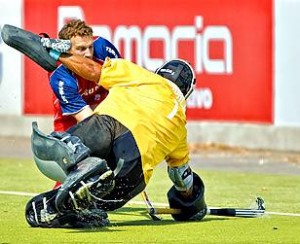Diving stick side is the most obvious example of an athletic goalkeeper, with the goalie extended out low to the stick side to stop the ball along the ground. This is the most basic dive, the one websites or team training session leaders preached to you about. It’s the simplest, and the most obvious; it generally implies diving to the right with your stick. Diving stick side allows you to reach out to low shots that go past you on your right side, on shots that are often out of reach. Make sure you follow through with the saving motion; watching the ball into the save to ensure that you make full contact with your stick to stop the ball getting past you.


To make a successful diving stick save, you should follow this process:
-
Step off with your right foot in the direction of the shot
-
Lean out to the right and crouch slightly for the dive
-
Driving from the flat of your foot, make sure you get enough power in the movement
-
Dive out with your stick arm extended towards the incoming ball (if necessary, you can extend the stick out to get further reach)
-
Land onto the pitch, pushing the stick out to make contact with the ball for the save; angling the stick diagonally to push away the rebound
-
When landing the save, land on the hips and arms, absorbing the impact, landing the stick to make contact with the floor
-
Ball makes connection with the stick, which is then stopped and cleared to safety, if possible
-
After making the save, recover to the standing stance, ready for the next shot: be quick to react, so you don’t give the shooter extra time
Pointers
Stay low throughout the dive to cover the shot. When executing the save, slide the stick out and along the ground to control the dive. If the ball is still out of reach, you can extend your stick out to get distance on the save. You can angle the stick towards the back line to direct the ball to safety.
Avoid landing on the elbow, which will otherwise get easily damaged after continually diving onto it. Instead, try to land on your forearm (the front of the arm – elbow to wrist); pushing out with your arm to drop there.
The first picture is from Yahoo Euro Sport images; the second from Alex Master’s sports action photography www.alex-masters.com